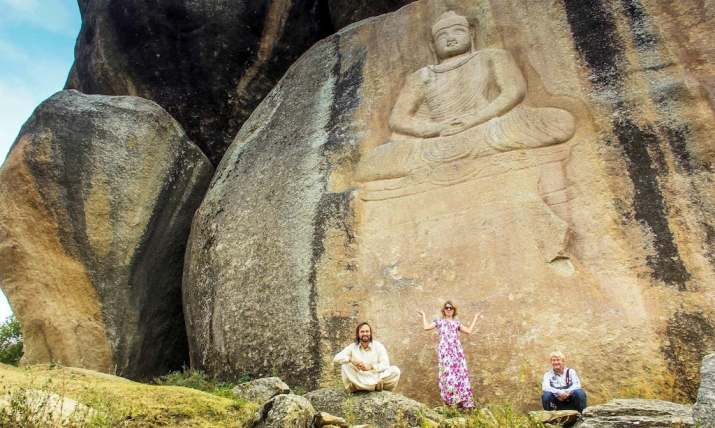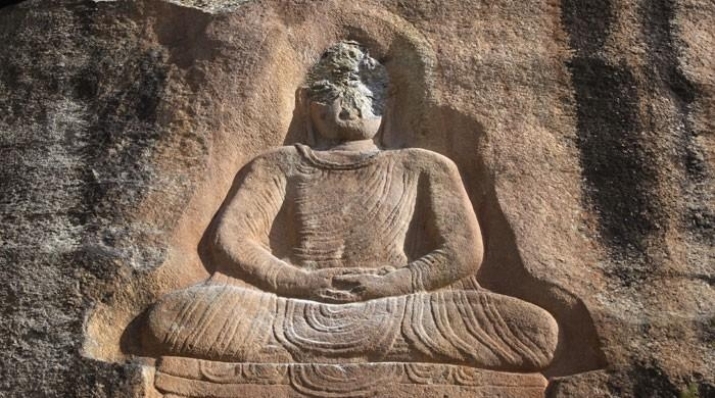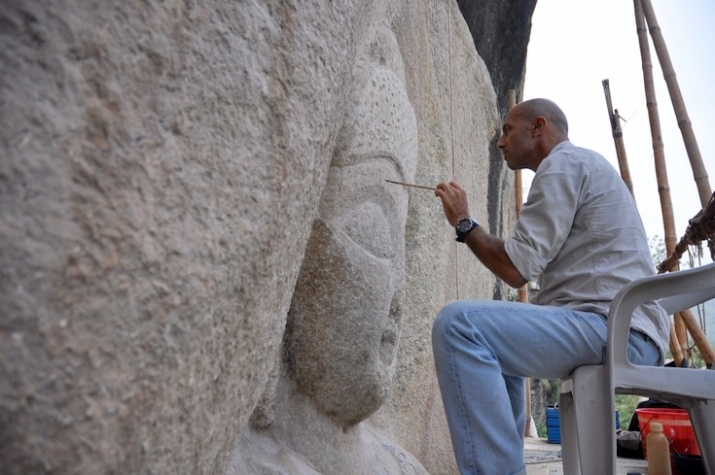NEWS
7th Century Buddha Image in Pakistan Restored Nine Years After Islamist Desecration
 Russian tourists beneath the newly restored Buddha image. From lionsroar.com
Russian tourists beneath the newly restored Buddha image. From lionsroar.comA beautiful Buddha image carved into a rock face at Jehanabad in a valley of Pakistan’s Swat District has been restored, nine years after being defaced by the Taliban in 2007. The restoration project was jointly conducted by Pakistan’s provincial government of Kyaber Pakhtunkhwa and the Italian Archaeological Mission. On 7 November, the team of archaeologists had finally restored the statue to an approximation of its original form.
The carving, which depicts the Buddha in a meditative pose, dates back to the 7th century, an age of high art and culture on the Indian subcontinent (and the diffusion of tantric Buddhism throughout South Asia). In September 2007, the image was attacked by the Taliban, a political Islamist movement, who drilled and inserted explosives into the face and shoulders. The defacement of the sculpture was met with worldwide anger, especially among the Buddhist community, historians, and archaeologists.
“It was our professional and moral obligation toward the people and heritage of Swat and Pakistan which forced us to restore the Buddha. It took about five missions of about a month each from 2012–16 in its complete conservation program,” said Luca Maria Olivieri, head of the Italian Archaeological Mission. (The Indian Express)
 The formerly defaced statue. From dawn.com
The formerly defaced statue. From dawn.comThe sculpture is considered one of the largest pieces of Buddhist art carved into stone in South Asia at 21 feet high and 12 feet wide, the statue is an icon of Gandhara-style art—a style of Buddhist art that developed in what is now northwestern Pakistan and eastern Afghanistan between the 1st century BCE and the 7th century CE.
“It is one of the biggest rock sculptures in the region and different traces showed that it was once a central Buddhist location in the past,” said Fabio Colombo, a restorer and member of the Italian Archaeological Mission. “The surrounding of Buddha statue [sic] is peaceful, picturesque and serene. Owing to its historical, religious, and archaeological importance. [sic] I hope local people understand its value as it is one part of their history which also belongs to the entire world.” (Scroll.in)
In 2012, the Italian team undertook the restoration of the desecrated image, deploying the latest 3D technology. “Two restorers/trainers, two 3D scan experts/trainers, one chief restorer, five local restorers, 20 field workers, two carpenters, and three watch-keepers were involved in the restoration process, while the 3D equipment was provided all-inclusive by the University of Padua, Italy,” said Olivieri. (Scroll.in)
 Conservator Fabio Colombo puts the final touches to his restoration of the Buddha's face. From lionsroar.com
Conservator Fabio Colombo puts the final touches to his restoration of the Buddha's face. From lionsroar.comAt one time, the sculpture drew a large number of tourists to the Swat Valley, including Tibetan pilgrims and archaeology enthusiasts. Syed Niaz Ali Shah, an official and representative of Pakistan’s archaeology department who accompanied the Italian Archaeological Mission, hopes that the site will become a popular tourist spot once again: “I hope Buddhist visitors and other tourists will once again visit this place, not only to enjoy the area serenity but the rich cultural heritage of the region here.” (Scroll.in)
See more
Iconic Buddha in Swat valley restored after nine years when Taliban defaced it (Dawn)
Iconic Buddha statue in Pakistan restored years after Taliban defaced it (The Indian Express)
Historic Buddha statue in Swat restored nine years after Taliban destroyed it (Geo TV)
Nine years after Taliban defaced a historic Buddha statue in Pakistan, it has been restored (Scroll.in)
Destroyed by Taliban nine years ago, iconic “Jahanabad Buddha” is reborn (Lion’s Roar)














